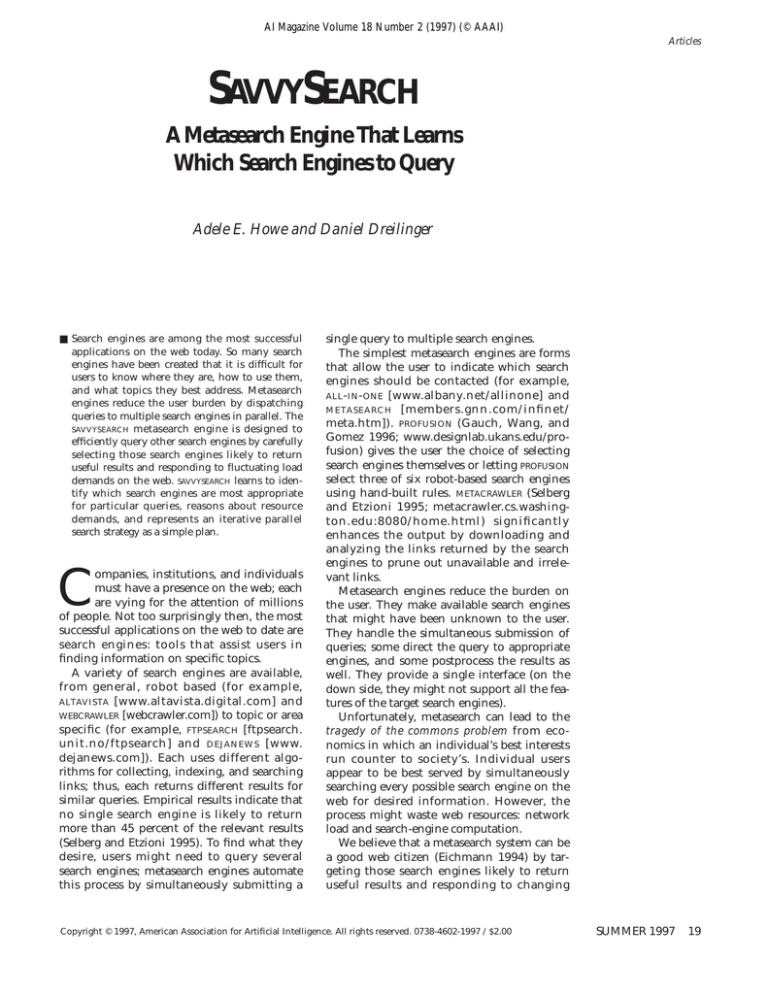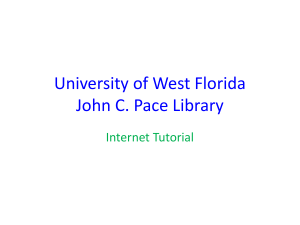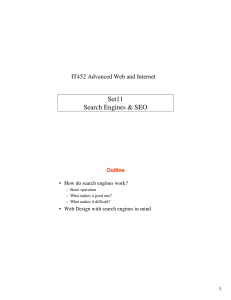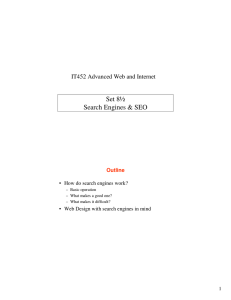
AI Magazine Volume 18 Number 2 (1997) (© AAAI)
Articles
SAVVYSEARCH
A Metasearch Engine That Learns
Which Search Engines to Query
Adele E. Howe and Daniel Dreilinger
■ Search engines are among the most successful
applications on the web today. So many search
engines have been created that it is difficult for
users to know where they are, how to use them,
and what topics they best address. Metasearch
engines reduce the user burden by dispatching
queries to multiple search engines in parallel. The
SAVVYSEARCH metasearch engine is designed to
efficiently query other search engines by carefully
selecting those search engines likely to return
useful results and responding to fluctuating load
demands on the web. SAVVYSEARCH learns to identify which search engines are most appropriate
for particular queries, reasons about resource
demands, and represents an iterative parallel
search strategy as a simple plan.
C
ompanies, institutions, and individuals
must have a presence on the web; each
are vying for the attention of millions
of people. Not too surprisingly then, the most
successful applications on the web to date are
search engines: tools that assist users in
finding information on specific topics.
A variety of search engines are available,
from general, robot based (for example,
ALTAVISTA [www.altavista.digital.com] and
WEBCRAWLER [webcrawler.com]) to topic or area
specific (for example, FTPSEARCH [ftpsearch.
unit.no/ftpsearch] and D E J A N E W S [www.
dejanews.com]). Each uses different algorithms for collecting, indexing, and searching
links; thus, each returns different results for
similar queries. Empirical results indicate that
no single search engine is likely to return
more than 45 percent of the relevant results
(Selberg and Etzioni 1995). To find what they
desire, users might need to query several
search engines; metasearch engines automate
this process by simultaneously submitting a
single query to multiple search engines.
The simplest metasearch engines are forms
that allow the user to indicate which search
engines should be contacted (for example,
ALL - IN - ONE [www.albany.net/allinone] and
M E TA S E A R C H [members.gnn.com/infinet/
meta.htm]). PROFUSION (Gauch, Wang, and
Gomez 1996; www.designlab.ukans.edu/profusion) gives the user the choice of selecting
search engines themselves or letting PROFUSION
select three of six robot-based search engines
using hand-built rules. METACRAWLER (Selberg
and Etzioni 1995; metacrawler.cs.washington.edu:8080/home.html) significantly
enhances the output by downloading and
analyzing the links returned by the search
engines to prune out unavailable and irrelevant links.
Metasearch engines reduce the burden on
the user. They make available search engines
that might have been unknown to the user.
They handle the simultaneous submission of
queries; some direct the query to appropriate
engines, and some postprocess the results as
well. They provide a single interface (on the
down side, they might not support all the features of the target search engines).
Unfortunately, metasearch can lead to the
tragedy of the commons problem from economics in which an individual’s best interests
run counter to society’s. Individual users
appear to be best served by simultaneously
searching every possible search engine on the
web for desired information. However, the
process might waste web resources: network
load and search-engine computation.
We believe that a metasearch system can be
a good web citizen (Eichmann 1994) by targeting those search engines likely to return
useful results and responding to changing
Copyright © 1997, American Association for Artificial Intelligence. All rights reserved. 0738-4602-1997 / $2.00
SUMMER 1997
19
Articles
load demands on the web. To provide this
function, we incorporated simple AI techniques in a metasearch engine. Our
metasearch engine learns to identify which
search engines are most appropriate for particular queries, r easons about resource
demands, and represents an iterative parallel
search strategy as a simple plan.
Our Metasearch System:
SAVVYSEARCH
SAVVYSEARCH
is designed to
balance two
potentially
conflicting
goals: (1)
maximizing
the likelihood
of returning
good links
and (2)
minimizing
computational and
web resource
consumption.
S AV V Y S E A R C H is our metasearch system
(Dreilinger and Howe 1997, 1996) available at
guaraldi.cs.colostate.edu:2000. It runs on five
machines (three Sun SPARCSTATIONs and two
IBM RS 6000s) at Colorado State University.
The system was first made available in March
1995 and has undergone several revisions
since the original design. At present, two versions of the system are available: (1) the one
described here and (2) an experimental interface that is mentioned in the section entitled
Retrospective and Prospective Views of the
SAVVYSEARCH Project.
SAVVYSEARCH is designed to balance two
potentially conflicting goals: (1) maximizing
the likelihood of returning good links and (2)
minimizing computational and web resource
consumption. The key to compromise is
knowing which search engines to contact for
specific queries at particular times. SAVVY S E A R C H tracks long-term performance of
search engines on specific query terms to
determine which are appropriate and monitors recent performance of search engines to
determine whether it is even worth trying to
contact them.
In this section, we describe SAVVYSEARCH
from a user’s perspective. We follow a running example, indicating what a user sees
and what goes on behind the scenes in processing a search request.
Submitting a Query
To find out about artificial intelligence conferences, we enter the query, select the Integrate Results option, and click on the SAVVYSEARCH! button, as shown in an image of the
interface in figure 1. The search form, the
query interface to SAVVYSEARCH, asks the user
to specify a set of keywords (query terms) and
options for the search. Users typically enter
two query terms.
The options cover the treatment of the
terms, the display of results, and the interface
language. Query terms can be combined with
logical and (all query terms must be included
in documents) or or (any query term should
20
AI MAGAZINE
be present) or can be presented as an ordered
phrase. Three aspects of the results display
can be varied: (1) the number of links
returned, (2) the format of the links description, and (3) the timing. By default, 10 links
are displayed with the uniform resource locators (URLs) and descriptions when available,
and the results of each search engine are listed separately as they arrive. Alternatively, we
could change the number of links to 50,
return less or more description of the links,
and interleave the results of the separate
search engines. The interface is also available
in 23 different languages.1
Processing a Query
When a user submits the query, SAVVYSEARCH
must make two decisions: (1) how many
search engines to contact simultaneously and
(2) what order the search engines should be
contacted in. The first decision requires reasoning about the available resources and the
second about ranking the search engines.
Resource Reasoning Each search engine
queried expends network and local computational resources. Thus, modifying concurrency (number of search engines queried in parallel) is the best way to moderate resource
consumption. Concurrency is a function of
network load estimates, which are determined
from a lookup table created from observations of the network load at this time of day
in the past, and local central processing unit
load, which is computed using the UNIX
uptime command.
Concurrency has a base value of two; as
many as two additional units are added for
each load estimate for periods of low load.
Thus, the maximum concurrency value is six.
Ranking Search Engines
SAVVYSEARCH
includes both large robot-based search engines
and small specialized search engines in its set.
The large search engines are likely to return
links for any query, but these links might not
be as appropriate as links returned by a specialized search engine for a query in its area.
The purpose of ranking is to determine
which search engines are most worthwhile to
contact for a given query. Search engines are
ranked based on learned associations between
search engines and query terms (stored in a
metaindex) and recent data on search-engine
performance.
The metaindex—A compendium of
search experience: The metaindex maintains
associations between individual query terms
(simplified by stemming and case stripping)
and search engines as effectiveness values.
High positive values indicate excellent perfor-
Articles
Figure 1. User Interface to SAVVYSEARCH for Entering a Query.
mance of a search engine on queries containing a specific term; high negative values indicate extremely poor performance.
The effectiveness values are derived from
two types of observation of the results of
users’ searches. We used observations (passive
measures) because we obtained a low rate of
response to requests for user feedback as well
as some questionable responses. For each
search, we collect two types of information:
(1) no results, the search engine failed to
return links, and (2) visits, the number of
links that are explored by the user. No results
reduces confidence that the search engine is
appropriate for the particular query, and Visits indicates that the user found some
SUMMER 1997 21
Articles
Just as
primary
search
engines are
now a
resource for
metasearch
engines, so
metasearch
engines
should
become a
means of
achieving
higher-level
goals rather
than an end
in itself.
returned links to be inter esting and so
increases confidence.
SAVVYSEARCH uses a simple weight-adjustment scheme for learning effectiveness values. No results and Visits are treated as negative and positive reinforcement, respectively,
amortized by the number of terms in the
query. Thus, if a search engine returned nothing for the example query, the effectiveness
values for artificial, intelligence, and conferences
would each be reduced by one-thir d.
Although simple, this scheme proved to be
effective (see Retrospective and Prospective
Views of the SAVVYSEARCH Project for a brief
description of our evaluation of the learning).
Tracking recent performance: Search
engines occasionally are inaccessible or slow
to respond. Their network connections might
be at fault, or the engines themselves might
be experiencing problems or upgrades. SAVVYS E A R C H monitors recent performance by
recording the number of links returned (hits)
and the response time for the last five queries
submitted to each search engine. Given current use of the system, 5 queries corresponds
to about 45 seconds for the large, general
search engines and about 15 minutes for the
infrequently used search engines.
Calculating rank from experiences: For a
given query (q), a search engine’s (s) rank
(Rq,s) is its query score reduced by a penalty
for recent poor performance on hits (h) and
response time (r):
Rq,s = Qq,s – (Ps,h + Ps,r) .
Each term is normalized to a point between 0
and 1.
The equation for Qq,s is based on a common approach from information retrieval
called term frequency times inverse document
frequency (Witten, Moffat, and Bell 1994). The
query score, Qq,s, sums the metaindex values
for the terms in the query weighted by the
ubiquity of the query term and the search
engine:
Qq , s = ∑
t ∈q
Mt , s ∗ It
Ts
Mt,s is the weight from the metaindex of the
term t for search engine s. It is the inverse server frequency of the term, which estimates the
ubiquity of the query term; frequently occurring, common terms provide little information for distinguishing search-engine performance and so are discounted. Ts sums the
absolute values of all metaindex values for
search engine s; this term estimates the frequency of the overall use of the search
engine. Because the most general search
engines are likely to be used more frequently
22
AI MAGAZINE
and are likely to return something for any
query, their weights will tend to grow larger
and more quickly than the specialized search
engines. T s mitigates the tendency toward
their dominance, allowing more specialized
engines to be selected when appropriate.
The penalties (P s,h and P s,r ) are accrued
only if thresholds on the minimum number
of hits and the maximum response time are
exceeded. The thresholds have been set somewhat arbitrarily to an average of 1 hit and a
response time of 15 seconds. Once the
thresholds are passed, the penalties increase
quadratically to the worst-possible values:
zero for hits and a time-out of 45 seconds for
response time. Details of these equations are
available in Dreilinger (1996).
Dispatching a Query
The degree of parallelism determines how many
search engines to query; the rank order determines which search engines should be queried.
SAVVYSEARCH dispatches the query in parallel to
each of the indicated search engines. For each
search engine, a specialized interface agent formats the query according to the interface for
the search engine and submits it. The interface
agent waits a preset amount of time for a
response, handles errors that might occur, parses the result into a uniform format, and forwards it to another component for display.
Presenting Results
For our example query, the three search
engines contacted ( WEBCRAWLER , LYCOS , and
YELLOW PAGES) returned 30 different links with
similar names. The first nine are shown in an
image of the result page in figure 2. These
results were integrated; SAVVYSEARCH waited
until all results had been received and then
constructed a single ranked list. Results are
integrated by normalizing the scores returned
by search engines between 0 and 1.0 and
summing them for each link; links for search
engines that did not return scores were arbitrarily assigned a score of 0.5. Duplicate links
are listed with the names of all the search
engines that returned them.
The bottom of each results page displays
the search plan, as shown in figure 3. The
query was issued during a time of moderately
high demand; thus, each step includes only
three search engines. Search plans can
include from two to six search engines for
each step. The current version includes 11
search engines; the number fluctuates as
search engines appear, disappear, and merge.
To supplement the results collected so far,
the user can execute another step in the
Articles
Figure 2. SAVVYSEARCH Display of Results of Artificial Intelligence Conferences Query, Interleaved Display.
search plan by clicking on the one that looks
the most promising. The ordering represents
SAVVYSEARCH’s best guess about which search
engines will return the best results; the user
can easily override it by selecting a different
step. In one long-term study, we found that
users executed 1.42 steps in their search plans
on average.
Retrospective and Prospective
Views of the SAVVYSEARCH
Project Results
The SAVVYSEARCH Project has been quite successful. Currently, SAVVYSEARCH processes over
20,000 queries each day and, based on elec-
SUMMER 1997 23
Articles
Figure 3. Search Plan for Artificial Intelligence Conferences Query,
Which Allows Users to Continue Search if Current Results Are Inadequate.
tronic mail, has attracted a large well-satisfied
user base.
SAVVYSEARCH, as described here, is the result
of almost two years of work and a series of
studies (Dreilinger and Howe 1997). The current design of the resource reasoning and
learning algorithm resulted, in part, from the
results of these studies (Dreilinger 1996). We
studied the effects of the learning by starting
from a minimal metaindex (compiled from 2
days worth of data) and allowing it to accumulate experience over a 28-day period. We
found that our simple learning algorithm
improved performance on both Visits and No
results overall (including all search engines
24
AI MAGAZINE
and query terms): Visits averaged .36 in the
first 5 days and .42 in the last 5 days; No
results averaged .142 in the first 5 days and
.135 in the last. Thus, this learning algorithm
leads to better selection of good search
engines than the pruning of poor ones.
In a follow-up study, we examined how
much knowledge was needed to significantly
improve performance using learning. We
found that as few as 10 uses of a query term
results in a halving of No Results from .18 to
.09. Although Visits increases more slowly
with learning, an increase from .34 to .45 is
obtained with just 100 examples. By the end
of the study, the most used term (5000 uses)
Articles
had Visits of .76 and No results of .08. Given
the level of use of most search engines (millions of queries a day), metasearch engines
should have little difficulty in collecting
enough data to significantly improve performance through learning.
As web use and users becomes more sophisticated, metasearch will need to be able to be
personalized and embedded in other systems.
Metasearch currently takes a “one-size-fitsall” approach in which the knowledge underlying query processing is shared by all users.
A new experimental version of SAVVYSEARCH
(available on the main web page) takes a first
step toward personalization by dividing
searches into eight categories; each category
translates to a set of rules for creating a search
plan for this type of search. Ideally, users
themselves could create and store their own
stereotypical search plans or a system could
infer them.
Just as primary search engines are now a
resource for metasearch engines, so metasearch engines should become a means of
achieving higher-level goals rather than an
end in itself. Intelligent-agent technology
promises to alleviate the tedium and frustration of mundane tasks and navigate vast
information spaces. Metasearch should be an
information-gathering tool for helping
human users and their intelligent agents find
what they need on the web.
The web will continue to grow. Thus,
search tools will continue to be critical for
managing the information deluge. To keep
pace with the expansion, the next generation
must include far more sophisticated AI techniques than the current but retain some of
the benefits of the current systems: be easy to
use, require little feedback from the users,
and be mindful of shared resources.
Acknowledgments
The experiments and equipment were supported in part by Advanced Research Projects
Agency–Air Force Office of Scientific Research
contract F30602-93-C-0100, National Science
Foundation (NSF) Research Initiation Award
IRI-930857, and NSF Car eer Award IRI9624058. We gratefully acknowledge the
assistance of Lawrence Livermore Laboratory
and the Computer Science Department at
Colorado State University for providing
machines to run SAVVYSEARCH and Wayne Trzyna and his staff for patiently keeping the
machines running.
References
Dreilinger, D. 1996. Description and Evaluation of
a Meta-Search Agent. Master’s thesis, Computer Science Dept., Colorado State University.
Dreilinger, D., and Howe, A. 1997. Experiences
with Selecting Search Engines Using Meta-Search.
ACM Transactions on Information Systems. Forthcoming.
Dreilinger, D., and Howe, A. 1996. An InformationGathering Agent for Querying Web Search Engines,
Technical Report, TR 96-11, Computer Science
Department, Colorado State University.
Eichmann, D. 1994. Ethical Web Agents. In Electronic Proceedings of the Second World Wide Web
Conference ‘94: MOSAIC and the Web, 17–20 October, Chicago, Illinois.
Gauch, S.; Wang, G.; and Gomez, M. 1996. PROFUSION : Intelligent Fusion from Multiple, Different
Search Engines. Journal of Universal Computer Science
2(9).
Selberg, E., and Etzioni, O. 1995. Multi-Service
Search and Comparison Using the METACRAWLER .
Presented at the Fourth International World Wide
Web Conference, 11 to 14 December, Boston, Massachusetts.
Witten, I. H.; Moffat, A.; and Bell, T. C. 1994. Managing Gigabytes: Compressing and Indexing Documents
and Images. New York: Van Nostrand Reinhold.
Adele E. Howe is an assistant
professor in the Computer Science Department at Colorado
State University. Her research
areas include planning, agent
architectures, information gathering on the World Wide Web, and
evaluation and modeling of intelligent systems. She received her
B.S.E. in computer science from the University of
Pennsylvania and her M.S. and Ph.D. in computer
science from the University of Massachusetts. She
can be reached at howe@cs.colostate.edu or
www.cs.colostate.edu/~howe.
Daniel Dreilinger received a B.A.
in mathematics from the University of California at San Diego in
1992. In 1996, he received an
M.S. in computer science from
Colorado State University, where
he created SAVVYSEARCH. Currently,
he is a research assistant at the
MIT Media Lab working on a second M.S. Research interests include information
filtering and retrieval, intelligent agents, and electronic commerce. He can be reached at
daniel@media.mit.edu or www.media.mit.edu/
~daniel/.
Note
1. We thank the users who translated the interface
for us.
SUMMER 1997 25
Diagrammatic Reasoning
Cognitive & Computational Perspectives
Edited by Janice Glasgow, N. Hari Narayanan, and B. Chandrasekaran
Foreword by Herbert Simon
“Understanding diagrammatic thinking will be of special importance to those who design human-computer
interfaces, where the diagrams presented on computer screens must find their way to the Mind’s Eye.… In a
society that is preoccupied with ‘Information Superhighways,’ a deep understanding of diagrammatic reasoning will be essential to keep the traffic moving.” – Herbert Simon
Diagrammatic reasoning—the understanding of concepts and ideas by the use of diagrams and imagery, as
opposed to linguistic or algebraic representations—not only allows us to gain insight into the way we think but is
a potential base for constructing representations of diagrammatic information that can be stored and processed by
computers.
Diagrammatic Reasoning brings together nearly two dozen recent investigations into the cognitive, the logical, and
particularly the computational characteristics of diagrammatic representations and the reasoning that can be done
with them. Following a foreword by Herbert Simon (coauthor of one of the most influential papers on reasoning
with diagrams, which is included here) and an introduction by the editors, chapters provide an overview of the
recent history of the subject, survey and extend the underlying theory of diagrammatic representation, and provide numerous examples of diagrammatic reasoning (human and mechanical) that illustrate both its powers and
its limitations. Each of the book’s four sections begins with an introduction by an eminent researcher who provides an interesting personal perspective while he or she places the work in proper context.
ISBN 0-262-57112-9 800 pp., index. $50.00 softcover
The AAAI Press • Distributed by The MIT Press
Massachusetts Institute of Technology, Cambridge, Massachusetts 02142
To order, call toll free: (800) 356-0343 or (617) 625-8569. MasterCard and VISA accepted.






